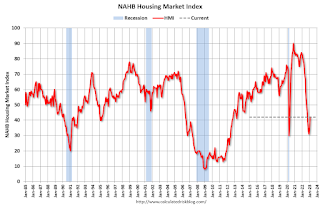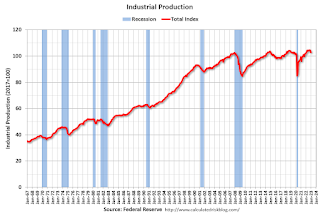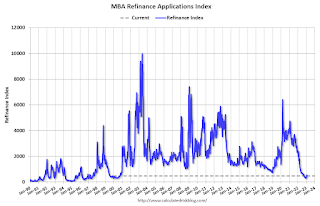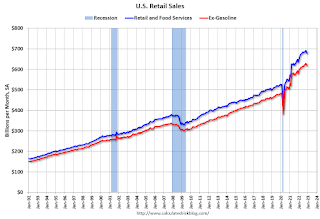by Calculated Risk on 2/15/2023 12:39:00 PM
Wednesday, February 15, 2023
Update: Some "Good News" for Homebuilders
Today, in the Calculated Risk Real Estate Newsletter: Update: Some "Good News" for Homebuilders
A brief excerpt:
Last October I wrote: Some "Good News" for HomebuildersThere is much more in the article. You can subscribe at https://calculatedrisk.substack.com/
I noted:Even though we can expect significant further declines in new home sales and single-family housing starts, the good news for the homebuilders is activity usually picks up quickly following an interest rate induced slowdown (as opposed to following the housing bust when the recovery took many years).I included the following graph to illustrate this point. The following graph shows new home sales for three periods: 1978-1982, 2005-2020, and current (red). The prior peak in sales is set to 100 (updated through the December New Home sales release).
...
My sense is this downturn will have some similarities to the 1980 period, see: Housing: Don't Compare the Current Housing Boom to the Bubble and Bust
NAHB: Builder Confidence Increased in February
by Calculated Risk on 2/15/2023 10:07:00 AM
The National Association of Home Builders (NAHB) reported the housing market index (HMI) was at 42, up from 35 last month. Any number below 50 indicates that more builders view sales conditions as poor than good.
From the NAHB: Cautious Optimism for Builders in February
Two consecutive solid monthly gains for builder confidence, spurred in part by easing mortgage rates, signal that the housing market may be turning a corner even as builders continue to contend with high construction costs and building material supply chain logjams. Builder confidence in the market for newly built single-family homes in February rose seven points to 42, according to the National Association of Home Builders (NAHB)/Wells Fargo Housing Market Index (HMI) released today. This is the strongest reading since September of last year.
...
“While the HMI remains below the breakeven level of 50, the increase from 31 to 42 from December to February is a positive sign for the market,” said NAHB Chief Economist Robert Dietz. “Even as the Federal Reserve continues to tighten monetary policy conditions, forecasts indicate that the housing market has passed peak mortgage rates for this cycle. And while we expect ongoing volatility for mortgage rates and housing costs, the building market should be able to achieve stability in the coming months, followed by a rebound back to trend home construction levels later in 2023 and the beginning of 2024.”And while builders continue to offer a variety of incentives to attract buyers during this housing downturn, recent data indicate that the housing market is showing signs of stabilizing off a cyclical low:
• 31% of builders reduced home prices in February, down from 35% in December and 36% in November.
• The average price drop in February was 6%, down from 8% in December, and tied with 6% in November.
• 57% offered some kind of incentive in February, down from 62% in December and 59% in November.
...
All three HMI indices posted gains for the second consecutive month. The HMI index gauging current sales conditions in February rose six points to 46, the component charting sales expectations in the next six months increased 11 points to 48 and the gauge measuring traffic of prospective buyers increased six points to 29.
Looking at the three-month moving averages for regional HMI scores, the Northeast rose four points to 37, the Midwest edged one-point higher to 33, the South increased four points to 40 and the West moved three points higher to 30
emphasis added
 Click on graph for larger image.
Click on graph for larger image.This graph shows the NAHB index since Jan 1985.
This was above the consensus forecast.
Industrial Production Unchanged in January
by Calculated Risk on 2/15/2023 09:22:00 AM
From the Fed: Industrial Production and Capacity Utilization
Industrial production was unchanged in January after falling 0.6 percent and 1.0 percent in November and December, respectively. In January, manufacturing output moved up 1.0 percent and mining output rose 2.0 percent following two months with substantial decreases for each sector. The output of utilities fell 9.9 percent in January, as a swing from unseasonably cool weather in December to unseasonably warm weather in January depressed the demand for heating. At 103.0 percent of its 2017 average, total industrial production in January was 0.8 percent above its year-earlier level. Capacity utilization declined 0.1 percentage point in January to 78.3 percent, a rate that is 1.3 percentage points below its long-run (1972–2022) average.
emphasis added
 Click on graph for larger image.
Click on graph for larger image.This graph shows Capacity Utilization. This series is up from the record low set in April 2020, and above the level in February 2020 (pre-pandemic).
Capacity utilization at 78.3% is 1.3% below the average from 1972 to 2021. This was below consensus expectations.
Note: y-axis doesn't start at zero to better show the change.
 The second graph shows industrial production since 1967.
The second graph shows industrial production since 1967.Industrial production increased slightly in January to 103.0. This is above the pre-pandemic level.
The change in industrial production was below consensus expectations.
Retail Sales Increased 3.0% in January
by Calculated Risk on 2/15/2023 08:39:00 AM
On a monthly basis, retail sales were up 3.0% from December to January (seasonally adjusted), and sales were up 6.4 percent from January 2022.
From the Census Bureau report:
Advance estimates of U.S. retail and food services sales for January 2023, adjusted for seasonal variation and holiday and trading-day differences, but not for price changes, were $697.0 billion, up 3.0 percent from the previous month, and up 6.4 percent above January 2022.
emphasis added
 Click on graph for larger image.
Click on graph for larger image.This graph shows retail sales since 1992. This is monthly retail sales and food service, seasonally adjusted (total and ex-gasoline).
Retail sales ex-gasoline were up 3.2% in January.
The second graph shows the year-over-year change in retail sales and food service (ex-gasoline) since 1993.
Retail and Food service sales, ex-gasoline, increased by 6.8% on a YoY basis.
 Sales in January were well above expectations, however, sales in November and December were revised down, combined.
Sales in January were well above expectations, however, sales in November and December were revised down, combined.
MBA: Mortgage Applications Decreased in Latest Weekly Survey
by Calculated Risk on 2/15/2023 07:00:00 AM
From the MBA: Mortgage Applications Decrease in Latest MBA Weekly Survey
Mortgage applications decreased 7.7 percent from one week earlier, according to data from the Mortgage Bankers Association’s (MBA) Weekly Mortgage Applications Survey for the week ending February 10, 2023.
... The Refinance Index decreased 13 percent from the previous week and was 76 percent lower than the same week one year ago. The seasonally adjusted Purchase Index decreased 6 percent from one week earlier. The unadjusted Purchase Index decreased 5 percent compared with the previous week and was 43 percent lower than the same week one year ago.
“Mortgage rates increased across the board last week, pushed higher by market expectations that inflation will persist, thus requiring the Federal Reserve to keep monetary policy restrictive for a longer time. After five straight weeks of decreases, the 30-year fixed rate increased by 21 basis points to 6.39 percent,” said Joel Kan, MBA’s Vice President and Deputy Chief Economist. “Mortgage applications decreased for the second time in three weeks because of these higher rates. Refinance borrowers, both rate/term and cash-out, remain on the sidelines as current rates provide little financial incentive to act.”
Added Kan, “Purchase applications dropped to their lowest level since the beginning of this year and were more than 40 percent lower than a year ago. Potential buyers remain quite sensitive to the current level of mortgage rates, which are more than two percentage points above last year’s levels and have significantly reduced buyers’ purchasing power.”
...
The average contract interest rate for 30-year fixed-rate mortgages with conforming loan balances ($726,200 or less) increased to 6.39 percent from 6.18 percent, with points increasing to 0.70 from 0.64 (including the origination fee) for 80 percent loan-to-value ratio (LTV) loans.
emphasis added
 Click on graph for larger image.
Click on graph for larger image.The first graph shows the refinance index since 1990.
 According to the MBA, purchase activity is down 43% year-over-year unadjusted. This has increased a little with lower rates but is still near housing bust levels.
According to the MBA, purchase activity is down 43% year-over-year unadjusted. This has increased a little with lower rates but is still near housing bust levels.Tuesday, February 14, 2023
Wednesday: Retail Sales, Industrial Production, Homebuilder Survey, NY Fed Mfg
by Calculated Risk on 2/14/2023 09:01:00 PM

Wednesday:
• At 7:00 AM ET, The Mortgage Bankers Association (MBA) will release the results for the mortgage purchase applications index.
• At 8:30 AM, Retail sales for January is scheduled to be released. The consensus is for a 1.5% increase in retail sales.
• Also at 8:30 AM, The New York Fed Empire State manufacturing survey for February. The consensus is for a reading of -20.0, up from -32.9.
• At 9:15 AM, The Fed will release Industrial Production and Capacity Utilization for January. The consensus is for a 0.5% increase in Industrial Production, and for Capacity Utilization to increase to 79.1%.
• At 10:00 AM, The February NAHB homebuilder survey. The consensus is for a reading of 37, up from 35. Any number below 50 indicates that more builders view sales conditions as poor than good.
Cleveland Fed: Median CPI increased 0.7% and Trimmed-mean CPI increased 0.6% in January
by Calculated Risk on 2/14/2023 04:20:00 PM
The Cleveland Fed released the median CPI and the trimmed-mean CPI:
According to the Federal Reserve Bank of Cleveland, the median Consumer Price Index rose 0.7% in January. The 16% trimmed-mean Consumer Price Index increased 0.6% in January. "The median CPI and 16% trimmed-mean CPI are measures of core inflation calculated by the Federal Reserve Bank of Cleveland based on data released in the Bureau of Labor Statistics’ (BLS) monthly CPI report".
 Click on graph for larger image.
Click on graph for larger image.This graph shows the year-over-year change for these four key measures of inflation.
Note: The Cleveland Fed released the median CPI details. "Fuel oil and other fuels" decreased at a 38% annualized rate in January, and "Used Cars" decreased at a 21% annualized rate.
Current State of the Housing Market: Overview for mid-February
by Calculated Risk on 2/14/2023 08:53:00 AM
Today, in the Calculated Risk Real Estate Newsletter: Current State of the Housing Market: Overview for mid-February
A brief excerpt:
Here is a graph of new listing from Realtor.com’s January Housing Trends Report showing new listings were down about 5% year-over-year in January. Although new listings are at a record low for January, the year-over-year decline was smaller in January than in Q4 2022. From Realtor.com:There is much more in the article. You can subscribe at https://calculatedrisk.substack.com/In January, the number of homes newly-listed for sale declined by 5.4% compared to the same time last year. This is a much lower rate of decline than last month’s 21.0% decrease and November’s 17.2% decrease. However, new listings remain 25.0% below pre-pandemic 2017 to 2019 levels.And the local markets I track that have reported so far, show new listings were down less in January than in December.
For these areas, new listings were down 9.2% YoY. … Last month, new listings in these markets were down 21.7% YoY. This is a significantly smaller YoY decline in new listings, and something to watch.
Core CPI ex-Shelter declines to 3.9% YoY
by Calculated Risk on 2/14/2023 08:42:00 AM
The good news is that inflation has clearly peaked. And since rents are falling faster than seasonally normal - due to the pandemic related changes in household formation - it makes sense for the short term to use core CPI ex-shelter.
NOTE: There was a surge in household formation during the pandemic, pushing up rents sharply, and now household formation has slowed sharply just as more supply will be coming on the market.

This graph shows the year-over-year change in Core CPI ex-Shelter (blue), and the one month change annualized (red). The year-over-year change was at 3.9% in January, down from 4.5% in December.
BLS: CPI increased 0.5% in January; Core CPI increased 0.4%
by Calculated Risk on 2/14/2023 08:32:00 AM
The Consumer Price Index for All Urban Consumers (CPI-U) rose 0.5 percent in January on a seasonally adjusted basis, after increasing 0.1 percent in December, the U.S. Bureau of Labor Statistics reported today. Over the last 12 months, the all items index increased 6.4 percent before seasonal adjustment.Both CPI and core CPI were at expectations. I'll post a graph later today after the Cleveland Fed releases the median and trimmed-mean CPI.
The index for shelter was by far the largest contributor to the monthly all items increase, accounting for nearly half of the monthly all items increase, with the indexes for food, gasoline, and natural gas also contributing. The food index increased 0.5 percent over the month with the food at home index rising 0.4 percent. The energy index increased 2.0 percent over the month as all major energy component indexes rose over the month.
The index for all items less food and energy rose 0.4 percent in January. Categories which increased in January include the shelter, motor vehicle insurance, recreation, apparel, and household furnishing s and operations indexes. The indexes for used cars and trucks, medical care, and airline fares were among those that decreased over the month.
The all items index increased 6.4 percent for the 12 months ending January; this was the smallest 12-month increase since the period ending October 2021. The all items less food and energy index rose 5.6 percent over the last 12 months, its smallest 12-month increase since December 2021. The energy index increased 8.7 percent for the 12 months ending January, and the food index increased 10.1 percent over the last year.
emphasis added
Monday, February 13, 2023
Tuesday: CPI
by Calculated Risk on 2/13/2023 08:58:00 PM

Tuesday:
• At 6:00 AM ET, NFIB Small Business Optimism Index for January.
• At 8:30 AM, The Consumer Price Index for January from the BLS. The consensus is for 0.5% increase in CPI, and a 0.4% increase in core CPI. The consensus is for CPI to be up 6.2% year-over-year and core CPI to be up 5.5% YoY.
Demographics for Housing are not as Favorable as Projected 3 Years Ago
by Calculated Risk on 2/13/2023 01:15:00 PM
Almost a decade ago, I was positive on household formation and new home sales in the 2020s due to demographics.
Census 2017 materially over-predicted births, materially under-predicted deaths (mainly for non-elderly adults), and somewhat over-predicted net international migration (NIM) for each of the last several years.
In 2020, the Census Bureau had four immigration alternatives: main, low, high - and no immigration.
Using recently released data for 2022 - see Net Immigration and Household Formation - we can compare the various 2020 projections for 2022 with 2022 actuals.
2022 Actual: 333,287,557
2020 Census Main: 337,342,000
2020 Census Low: 334,289,000
2020 Census High: 341,921,000
2020 Census None: 328,183,000
So, the actual was less than the low immigration projections from 3 years ago, although immigration was somewhat above housing economist Tom Lawler's projections last year. It is important to continually adjust our outlook based on updated data!
2nd Look at Local Housing Markets in January
by Calculated Risk on 2/13/2023 09:27:00 AM
Today, in the Calculated Risk Real Estate Newsletter:
2nd Look at Local Housing Markets in January
A brief excerpt:
This is the second look at local markets in January. I’m tracking about 40 local housing markets in the US. Some of the 40 markets are states, and some are metropolitan areas. I’ll update these tables throughout the month as additional data is released.There is much more in the article. You can subscribe at https://calculatedrisk.substack.com/
Closed sales in January were mostly for contracts signed in November and December. Since 30-year fixed mortgage rates were over 6% for all of November and December closed sales were down significantly year-over-year in January, however, the impact was probably not as severe as for closed sales in December (rates were the highest in October and November 2022 when contracts were signed for closing in December).
...
And here is a table for new listings in January. For these areas, new listings were down 9.2% YoY. Potential sellers that are locked into their current homes with low mortgage rates has pushed down new listings.
Last month, new listings in these markets were down 21.7% YoY. This is a significantly smaller YoY decline in new listings, and something to watch. There are certain markets - like Georgia and Florida - where new listings are up YoY!
Realtor.com is showing a much smaller YoY decline in new listings in January too.
...
Many more local markets to come!
Housing February 13th Weekly Update: Inventory Decreased 3.0% Week-over-week
by Calculated Risk on 2/13/2023 08:33:00 AM
 Click on graph for larger image.
Click on graph for larger image.This inventory graph is courtesy of Altos Research.

Mike Simonsen discusses this data regularly on Youtube.
Sunday, February 12, 2023
Sunday Night Futures
by Calculated Risk on 2/12/2023 10:58:00 PM
Weekend:
• Schedule for Week of February 12, 2023
Monday:
• No major economic releases scheduled.
From CNBC: Pre-Market Data and Bloomberg futures S&P 500 futures are down 14 and DOW futures are down 90 (fair value).
Oil prices were up over the last week with WTI futures at $79.01 per barrel and Brent at $85.70 per barrel. A year ago, WTI was at $93, and Brent was at $98 - so WTI oil prices are DOWN 15% year-over-year.
Here is a graph from Gasbuddy.com for nationwide gasoline prices. Nationally prices are at $3.37 per gallon. A year ago, prices were at $3.45 per gallon, so gasoline prices are down $0.08 per gallon year-over-year.
Weather Boosted Employment by About 125,000 in January
by Calculated Risk on 2/12/2023 08:11:00 AM
Just some interesting data:
The BLS also reported 382 thousand people that are usually full-time employees were working part time in January due to bad weather. The average for January over the previous 10 years was 831 thousand (median was 645 thousand). This series suggests weather positively impacted employment more than usual (boosting seasonally adjusted employment).
The San Francisco Fed estimates Weather-Adjusted Change in Total Nonfarm Employment (monthly change, seasonally adjusted). They use local area weather to estimate the impact on employment. For January, the BLS reported 517 thousand jobs added, the San Francisco Fed estimated that weather boosted employment by around 125 thousand.
So, we should expect some negative payback in coming months.
Saturday, February 11, 2023
Real Estate Newsletter Articles this Week: "Home Prices Declined in December; Down 5.3% since June"
by Calculated Risk on 2/11/2023 02:11:00 PM
At the Calculated Risk Real Estate Newsletter this week:
• Black Knight Mortgage Monitor: Home Prices Declined in December; Down 5.3% since June
• Freddie Mac House Price Index Declines for 7th Consecutive Month in December
• 1st Look at Local Housing Markets in January
• Net Immigration and Household Formation
This is usually published 4 to 6 times a week and provides more in-depth analysis of the housing market.
You can subscribe at https://calculatedrisk.substack.com/
Most content is available for free (and no Ads), but please subscribe!
Schedule for Week of February 12, 2023
by Calculated Risk on 2/11/2023 08:11:00 AM
The key reports this week are January CPI, Housing Starts, and Retail sales.
For manufacturing, the January Industrial Production report, and the February NY and Philly Fed manufacturing surveys will be released this week.
No major economic releases scheduled.
6:00 AM: NFIB Small Business Optimism Index for January.
8:30 AM: The Consumer Price Index for January from the BLS. The consensus is for 0.5% increase in CPI, and a 0.4% increase in core CPI. The consensus is for CPI to be up 6.2% year-over-year and core CPI to be up 5.5% YoY.
7:00 AM ET: The Mortgage Bankers Association (MBA) will release the results for the mortgage purchase applications index.
 8:30 AM: Retail sales for January is scheduled to be released. The consensus is for a 1.5% increase in retail sales.
8:30 AM: Retail sales for January is scheduled to be released. The consensus is for a 1.5% increase in retail sales.This graph shows retail sales since 1992. This is monthly retail sales and food service, seasonally adjusted (total and ex-gasoline).
8:30 AM: The New York Fed Empire State manufacturing survey for February. The consensus is for a reading of -20.0, up from -32.9.
 9:15 AM: The Fed will release Industrial Production and Capacity Utilization for January.
9:15 AM: The Fed will release Industrial Production and Capacity Utilization for January.This graph shows industrial production since 1967.
The consensus is for a 0.5% increase in Industrial Production, and for Capacity Utilization to increase to 79.1%.
10:00 AM: The February NAHB homebuilder survey. The consensus is for a reading of 37, up from 35. Any number below 50 indicates that more builders view sales conditions as poor than good.
8:30 AM: The initial weekly unemployment claims report will be released. The consensus is for 200 thousand initial claims, up from 196 thousand last week.
 8:30 AM: Housing Starts for January.
8:30 AM: Housing Starts for January. This graph shows single and multi-family housing starts since 1968.
The consensus is for 1.361 million SAAR, down from 1.382 million SAAR.
8:30 AM ET: The Producer Price Index for December from the BLS. The consensus is for a 0.4% increase in PPI, and a 0.3% increase in core PPI.
8:30 AM: the Philly Fed manufacturing survey for February. The consensus is for a reading of -6.7, up from -8.9.
11:00 AM: NY Fed: Q4 Quarterly Report on Household Debt and Credit
No major economic releases scheduled.
Friday, February 10, 2023
COVID Feb 10, 2023: Update on Cases, Hospitalizations and Deaths
by Calculated Risk on 2/10/2023 08:44:00 PM

| COVID Metrics | ||||
|---|---|---|---|---|
| Now | Week Ago | Goal | ||
| New Cases per Week2 | 282,827 | 285,702 | ≤35,0001 | |
| Hospitalized2 | 23,420 | 26,029 | ≤3,0001 | |
| Deaths per Week2 | 3,171 | 3,513 | ≤3501 | |
| 1my goals to stop weekly posts, 2Weekly for Cases, Currently Hospitalized, and Deaths 🚩 Increasing number weekly for Cases, Hospitalized, and Deaths ✅ Goal met. | ||||
 Click on graph for larger image.
Click on graph for larger image.This graph shows the weekly (columns) number of deaths reported.
Early Q1 GDP Tracking
by Calculated Risk on 2/10/2023 12:45:00 PM
It is very early in the quarter and some tracking estimates will start next week. It looks like Q4 GDP will be revised up in the second estimate to be released on February 23rd.
From BofA:
Data released since our last weekly lowered our 4Q tracking estimate by 0.1ppt to 3.2% q/q saar. ... Looking ahead to next week, we will start our tracker for 1Q US GDP with the January retail sales report. In addition, we will incorporate December business inventories, January housing starts and permits, CPI, PPI, and import prices into our 4Q and 1Q tracking estimates. [Feb 10th]From Goldman:
emphasis added
We boosted our Q1 GDP tracking estimate by 0.4pp to +0.8% (qoq ar). We left our past-quarter GDP tracking estimate for Q4 unchanged on a rounded basis at +3.2%, compared to +2.9% as originally reported. [Feb 7th estimate]And from the Altanta Fed: GDPNow
The GDPNow model estimate for real GDP growth (seasonally adjusted annual rate) in the first quarter of 2023 is 2.2 percent on February 8, up from 2.1 percent on February 7. [Feb 8th estimate]


